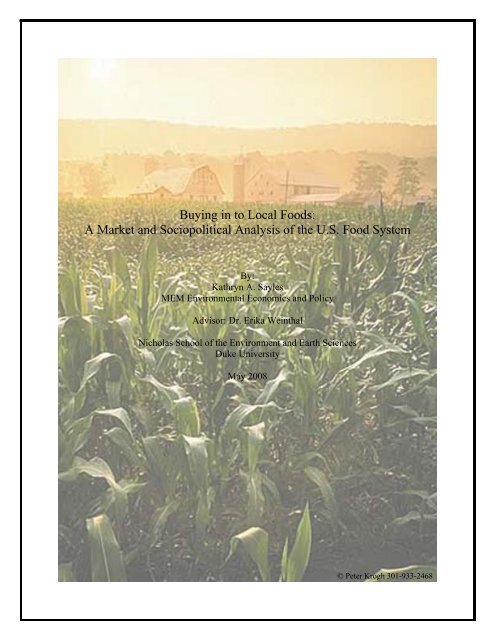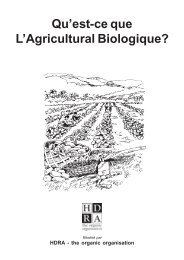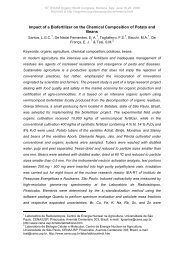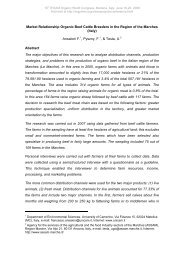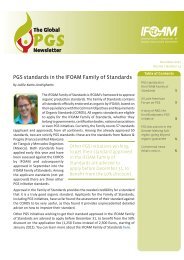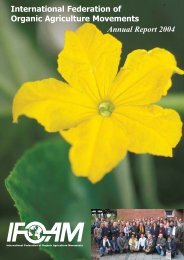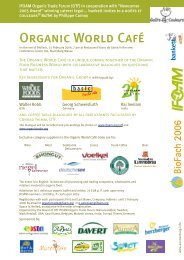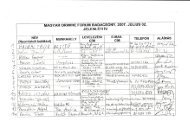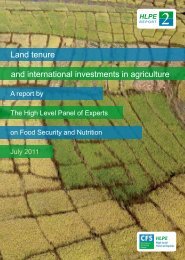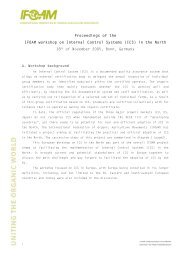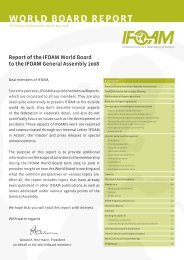Profiting from Best Management Practices: - DukeSpace
Profiting from Best Management Practices: - DukeSpace
Profiting from Best Management Practices: - DukeSpace
You also want an ePaper? Increase the reach of your titles
YUMPU automatically turns print PDFs into web optimized ePapers that Google loves.
Buying in to Local Foods:<br />
A Market and Sociopolitical Analysis of the U.S. Food System<br />
By:<br />
Kathryn A. Sayles<br />
MEM Environmental Economics and Policy<br />
Advisor: Dr. Erika Weinthal<br />
Nicholas School of the Environment and Earth Sciences<br />
Duke University<br />
May 2008<br />
© Peter Krogh 301-933-2468
“Evolution has shown us that nothing ever stays the same:<br />
continents drift across the oceans, jungles turn into deserts,<br />
and dinosaurs make way for silky anteaters. And where the wind and the<br />
sun once dictated the course of evolution, the near future of this planet<br />
resides in the mind and action of man. The balancing of and the struggle<br />
between greed, compassion, fear, and intelligence will now determine<br />
the destiny of all life on Earth.” –Charles Lynn Bragg<br />
2
TABLE OF CONTENTS<br />
Abstract 4<br />
Methods 4<br />
Justification for Research 5<br />
Driving Principles 6<br />
The Economics and Externalities of Agriculture 7<br />
An Industry in Conflict 12<br />
Local Food Takes the Stage 14<br />
Changing the U.S. Food System 18<br />
Funding Shift 20<br />
Business Incentives 20<br />
Green Label System 21<br />
Marketing Program 22<br />
Concluding Remarks and Project Impact 23<br />
Appendix 24<br />
3
ABSTRACT<br />
A considerable number of materials have been prepared ranging <strong>from</strong> “how to” booklets<br />
for local farmers to highly quantitative economic analyses of the United States food system.<br />
This report examines the economic and sociopolitical factors that must be overcome for local<br />
agricultural to be a truly sustainable solution to a slough of environmental problems. As this<br />
report will show, local farmers are, as a whole, more intimately tied to environmental issues and<br />
are thus more willing to adopt sustainable practices. Academics and professionals alike<br />
recognize the extreme hardships of transforming American agricultural policies. Nonetheless, a<br />
few comparatively simple measures can be taken to spur local farming initiatives. Overcoming<br />
the present barriers will require educational efforts, political reform and a fundamental shift in<br />
the current market paradigm. Each of these components can be driven by well-designed, clear<br />
and appropriate legislation. This document shows that a reasonable public policy must at least<br />
shift funding to sustain small farmers, provide incentives for businesses to support local farming<br />
initiatives, standardize food labels and publicize the benefits of buying local products in order to<br />
secure Earth’s natural resources and ensure community stability.<br />
METHODS<br />
Several methods were employed to answer the research question: “What market, social<br />
and political barriers must be removed to make local produce a truly viable alternative to<br />
industrialized farming practices?” Given the great abundance of literature available on best<br />
management practices, the Farm Bill and local agriculture, this investigation began with a<br />
thorough literature review. From this review particularly pertinent topics were explored with<br />
experts <strong>from</strong> the community, environmental consultants and members of the EPA. Later the<br />
structure of the Farm Bill was examined in conjunction with relevant market and social issues.<br />
4
Finally, a policy memorandum targeting state elected officials, the group that ultimately drives<br />
the success of the local products market, was created for distribution to local elected officials.<br />
Ultimately, this project offers suggestions for minimizing the barriers to local produce while<br />
maximizing environmental benefits.<br />
JUSTIFICATION FOR RESEARCH<br />
Agricultural practices can have significant impacts on both environmental and human<br />
health. As the population continues to grow, it becomes increasingly important how the public<br />
and elected officials alike choose to manage Earth’s resources. The following text shows how<br />
the current farming structure is not a socially desirable, economically feasible or ecologically<br />
viable solution to this national problem. Thus, much research has turned to alternative options<br />
such as organic farming and locally grown products in an attempt to provide consumers with a<br />
truly sustainable food system.<br />
Numerous studies have been conducted throughout the United States that examine the<br />
incentives for and barriers to local product consumption. 1 Additional studies have investigated<br />
the most affective economic and marketing strategies for promoting environmentally friendly<br />
foods, including local products. 2 Despite these notable research successes, few tools have been<br />
created that put these research findings into the hands of decision makers, producers, suppliers or<br />
consumers. Therefore, the success of local products has been notably limited.<br />
1 Burness, David and Brian Harris. Demands for Local and Organic Produce: A Brief Review of the Literature.<br />
Institute for Public Policy and Business Research. U. of Kansas. Lawrence, KN, April 2000. Tegtmeier, Erin.<br />
“Factors Affecting Symbolic and Use Adoption of Local Foods for Consumers in Black Hawk County, Iowa. Iowa<br />
State University, 2003. Wilson, Leah. “Local Food, Local Policy: A Case Study on Engaging Policy Makers in the<br />
Development of Their Foodshed.” The Leopold Center for Sustainable Agriculture. October 2007.<br />
2 Benbrook, Charles. “What Will It Take to Change the American Food System?” W.K. Kellogg Foundation Food<br />
and Society Networking Conference. The Woodlands Center. 23 April 2003. Berkenkamp, JoAnne and Pam<br />
Mavrolas. “Delivering the Goods: Market-Based Change in Phase II of the Integrated Farming Systems Initiative.”<br />
W.K. Kellogg Foundation. April 2002. Greenberg, Quinlan, Rosner Research Inc. “Building Support for Buying<br />
Local.” Foodroutes Network. Washington, DC. May 2002.<br />
5
Non-point source pollution <strong>from</strong> agricultural runoff has been identified as a major threat<br />
to human and environmental wellbeing. Moreover, current water and farm policies have been<br />
largely unsuccessful at minimizing these anthropogenic damages. Though a wide variety of<br />
research has examined the various successes and shortcoming of both types of policy, most of<br />
the results have not been incorporated into public policy. While skeptics of local produce argue<br />
that it is not a viable alternative, the organic food model proves that alternatives to industrialized<br />
agriculture are indeed possible.<br />
DRIVING PRINCIPLES<br />
In this research there are three primary principles that ultimately lead to both short and<br />
long term policy recommendations. As the following text will show, there is a growing problem<br />
of vertical integration in the agricultural arena that is taking profits away <strong>from</strong> farmers<br />
themselves. A few noteworthy papers have shown that buying local products breaks down some<br />
of these integrated levels and returns comparatively more money to farmers than more<br />
industrialized approaches. Thus, the first principle is that local products do indeed provide<br />
greater profits for farmers.<br />
Jennifer Curtis of Curtis Consulting demonstrated that insufficient funding is the primary<br />
barrier to the use of best management practices. Here, best management practices are considered<br />
to be effective, practical, structural or nonstructural methods which prevent or reduce the<br />
movement of sediment, nutrients, pesticides and other pollutants <strong>from</strong> the land to surface or<br />
ground water, or which otherwise protect water quality <strong>from</strong> potential adverse effects of<br />
silvicultural activities. 3 Second, it is noted that best management practices are effective in<br />
reducing the detrimental impacts of agriculture on waterways. That is to say that with additional<br />
3 Watershed management Protection Program. Division of Forestry and Wildlife, U of Hawaii. 18 Oct. 2007.<br />
< http://www.state.hi.us/dlnr/dofaw/wmp/bmps.htm>.<br />
6
funding provided <strong>from</strong> the sale of local products, farmers will be able to install best management<br />
practices that will indeed work to keep local waterways more pristine.<br />
Lastly, consumers are assumed to actually buy local products over other alternatives.<br />
This final principle holds true provided there is an increase in the availability of local products as<br />
well as an increase in consumers’ knowledge regarding the benefits of buying local products. As<br />
the following text will illustrate, several researchers have identified lack of availability and<br />
minimal knowledge of local products as the two main barriers to local product consumption.<br />
Thus, it is assumed that consumers’ stated preferences for local products do indeed coincide with<br />
their revealed preferences. Each of the aforementioned principles is supported by published<br />
research detailed in the report that follows. It is further worth noting that for the purpose of this<br />
research the term “local product” refers to an agricultural good that is produced within 100 miles<br />
of its final place of sale.<br />
THE ECONOMICS AND EXTERNALITIES OF AGRICULTURE<br />
Excessive consumption rates coupled with a rapidly growing population is placing an<br />
intolerable stress on the nation’s waterways. No longer able to disregard this prominent<br />
problem, in 2004 the U.S. Commission on Ocean Policy and the Pew Oceans Commission<br />
reported that U.S. coastal waters and oceans are in a state of crisis due, in part, to contaminated<br />
sediments and nutrient pollution. 4 Though agricultural operations are responsible for upwards of<br />
73 percent of the nutrient pollution in a given area, these non-point sources remain largely<br />
unregulated. 5 Land-based farming practices are often the major cause of eutrophication,<br />
pathogen increases and unfavorable oxygen situations including hypoxia. Indeed, large-scale<br />
4 Schnoor, J. L., “Coastal Waters Need Action.” American Chemical Society (2005): 55A.<br />
5 Schleich, J. and D. White. “Cost Minimization of Nutrient reduction in Watershed management Using Linear<br />
Programming.” Journal of the American Water Resources Association 33 (1997): 136.<br />
7
farming practices, in particular, can cause considerable harm to both human and environmental<br />
health. It is appallingly evident that the externalities of agricultural production reach well<br />
beyond the aforementioned aquatic impacts and attack community stability, economic security<br />
and overall environmental wellbeing.<br />
The price consumers pay for food at the grocery store does not illuminate the true cost of<br />
agriculture due to multiple externalities. Still, many Americans advocate for cheap food.<br />
Raising food prices is notably unpopular among elected officials and the general public alike,<br />
because it marginalizes the poor and further stresses household budgets. Despite the United<br />
States comparatively low costs for edible products, consumers pay for food in far great ways<br />
than merely their grocery store bill. As industrial agriculture grows, the negative impacts of<br />
these practices continue to threaten human and environmental vitality at all levels of production.<br />
Tegtmeier and Duffy estimate that the externalities of industrialized farming practices range<br />
<strong>from</strong> $5.7 to $16.9 billion annually, with $419.4 million per year being directly attributable to<br />
water resource damage. 6 In addition to this obvious financial burden borne by the general<br />
public, individuals are becoming increasingly marginalized in the decision making process<br />
regarding production methods. Therefore, consumers are unable to express their choice for local<br />
products because supply is so markedly limited. Moreover, there is a growing division of social<br />
classes due to the poorly defined property rights, market failures and economic inefficiencies<br />
fueling these externality problems. 7<br />
In an effort to address the environmental and human health aspects of these externalities,<br />
the United States have continually work to amend the Farm Bill with varied success.<br />
6 Tegtmeier, Erin and Michael Duffy. “External Costs of Agricultural Production in the United States.”<br />
International Journal of Agricultural Sustainability 2.1 (2004): 1, 6.<br />
7 Flora, J.L., C.J. Hodne, W. Goudy, D. Osterberg, J. Kliebenstein, K.M. Thu and S.P. Marquez. “Social and<br />
Community Impact.” Environmental Health Sciences Research Center Iowa State University, 2002.<br />
8
Unfortunately, the current structure of the Farm Bill serves primarily to uphold the status quo<br />
and recently proposed amendments have allocated little financial or political support for<br />
pollution prevention measures such as best management practices. From this fact it is evident<br />
that fundamental market forces play a major role in the structure of the food system and<br />
ultimately control many political decisions.<br />
For over two decades academics and professionals alike have voiced a discontent with<br />
the structure of the agricultural industry market. As Tegtmeier so eloquently notes, the<br />
globalization and concentration of market power increases the exploitation of segments of<br />
society as well as Earth’s resources and causes the decline of democratic and political power as<br />
economic, corporate powers continue to concentrate. 8 One of the most concerning aspects of<br />
this shift is the vertical integration of the food system at nearly all levels that marginalizes<br />
consumers. Consequently, the methods of food production, processing distribution are<br />
increasingly dictated with little negotiation. 9 What is more, there is an apparent, self-<br />
perpetuating status quo. Income streams dictate capital flows and consequently control the<br />
ability to carry out research and development. 10 Thus, those who have the greatest income have<br />
the resources to promote their own practices as well as information flows to consumers and<br />
policymakers alike.<br />
Agricultural endeavors must meet a variety of socioeconomic, political and ecologic<br />
demands while satisfying the exponentially increasing consumption rate of the American people.<br />
In December 2007 the United States Senate approved a $286 billion amendment to the Farm<br />
8 Tegtmeier, Erin. “Factors Affecting Symbolic and Use Adoption of Local Foods for Consumers in Black Hawk<br />
County, Iowa.” Iowa State University (2003): 1.<br />
9 Ibid., pp. 1<br />
10 Benbrook, Charles. “What Will It Take to Change the American Food System?” W.K. Kellogg Foundation Food<br />
and Society Networking Conference. The Woodlands Center. 23 April 2003: 6.<br />
9
Bill. 11 Clearly, agricultural practices are already very heavily subsidized. In fact, the magnitude<br />
of the Farm Bill’s funding comes second only to military expenses. The most classic approach<br />
to minimizing pollution is the identification and subsequent penalizing, most often in monetary<br />
form, of a polluter based on a set series of criteria. Despite the inherent hardships of sufficiently<br />
identifying agricultural non-point source polluters, administering government-issued penalties to<br />
an already heavily subsidized industry is simply economic nonsense. The government would<br />
ultimately be subsidizing their own fines, and making little progress towards finding a solution to<br />
the pollution problem. Moreover, it is not socially desirable or politically favorable to fine an<br />
industry that supports the nutritional needs of the nation. It is thus no surprise that the<br />
agricultural industry has largely escaped the fines traditionally issued to their point-source<br />
counterparts.<br />
Preventative measures can help reduce many of environmental externalities, but are still<br />
unable to tackle some of the more social problems. <strong>Best</strong> management practices (BMPs) are<br />
effective, practical, structural or nonstructural methods which prevent or reduce the movement of<br />
sediment, nutrients, pesticides and other pollutants <strong>from</strong> the land to surface or ground water, or<br />
which otherwise protect water quality <strong>from</strong> potential adverse effects of silvicultural activities. 12<br />
What is more, these practices seek to balance water quality protection with the production of<br />
crops given the environmental and economic constraints. Examples of best management<br />
practices with respect to agriculture include no-till practices, organic farming, riparian buffers<br />
and crop rotation. There exists a noteworthy body of literature that addresses the various benefits<br />
of and barriers to bmp use. For these reasons, the Environmental Protection Agency (EPA) has<br />
11 Farm Bill Expanding Subsidies. CNN. 4 Feb. 2008. .<br />
12 Watershed management Protection Program. Division of Forestry and Wildlife, U of Hawaii. 18 Oct. 2007.<br />
< http://www.state.hi.us/dlnr/dofaw/wmp/bmps.htm>.<br />
10
strongly considered and implemented these tools for agriculture-based water pollution<br />
prevention. Ironically, when these texts are examined together they show that best management<br />
practices often have prohibitive costs for farmers.<br />
Recognizing this financial and sociopolitical conflict, the federal government and its<br />
agencies have turned to various voluntary programs to provide incentives for promoting<br />
sustainable agricultural practices. For large and small local farmers alike who seek to make their<br />
practices more environmentally friendly, the Environmental Protection Agency (EPA) offers<br />
voluntary solution that will help them to avoid potentially costly penalties that would further<br />
deduct <strong>from</strong> their already narrow profit margins. Among the masses of bmp literature, the EPA<br />
highlights two key papers. 13 The first hails <strong>from</strong> the United States Department of Agriculture<br />
(USDA) and addresses “voluntary incentives for reducing agricultural non-point source water<br />
pollution.” The second is a product of Kansas State University’s Department of Agronomy and<br />
Department of Agricultural Economics, and looks at “water quality best management practices<br />
effectiveness, and cost for reducing contaminant losses <strong>from</strong> cropland.” Though each of these<br />
papers alone makes several convincing points regarding the success of BMP programs, together<br />
they illuminate the true dilemma facing the farming industry today. In light of even the greatest<br />
desires to improve environmental quality, local farmers are increasingly marginalized and unable<br />
to make the desired changes due to economic constraints. Jennifer Curtis, an environmental<br />
consultant in North Carolina, recently researched the absence of best management practices in<br />
certain areas and found that farmers recognize the need for environmental protection, and do<br />
13 Schultz, Martin. “<strong>Best</strong> <strong>Management</strong> Practice Advising.” Correspondence to Kathryn Sayles. 5 March 2007.<br />
11
actually want to use best management practices, but that they are unable to do so because of the<br />
associated costs. 14 These constraints are detailed as follows.<br />
AN INDUSTRY IN CONFLICT<br />
Local farmers have become increasingly marginalized due to market forces and distorted<br />
public policies. A national non-government organization (NGO) known as “Foodroutes” aptly<br />
notes that the United States has lost 4.7 million farms since 1935. In addition, in 2002 while the<br />
remaining farmers earned their lowest real net cash income in since 1940, corporate agribusiness<br />
profits have nearly doubled since 1990. 15 The resulting stratification of the food system is<br />
continually reinforced by the U.S. Farm Bill, widespread farm programs and many traditional<br />
market forces detailed above.<br />
The lack of sufficient funding to local farmers coupled with the self-perpetuating income<br />
stream drives the concentration and integration of the food system. Thus, it is now evident that<br />
income structure and market characteristics are self-perpetuating. One away to break down this<br />
detrimental tend is to fund innovative approaches such as local produce or organic farming.<br />
Many farm programs have been rightly initiated in an effort to provide local farmers with higher<br />
and more reliable income streams. Despite their good intentions, these programs ultimately<br />
force farmers to choose between sound environmental practices and a reliable revenue source.<br />
Furthermore, while some farmers have joined programs such as the conservation reserve<br />
program, and successfully worked to promote environmental sustainability, many farmers are<br />
denied access to such programs because the do not meet the strict guideline needed to obtain<br />
program funds. Indeed, farmers wishing to achieve good environmental outcomes on their farms<br />
14<br />
Curtis, Jennifer. “Inspiring Local Food Initiatives.” Correspondence to Kathryn Sayles November 2007.<br />
15<br />
Foodroutes.org “Plant Your Dollars Close to Home and Watch Your Community Grow.” 4 Feb. 2008<br />
< http://foodroutes.org/>.<br />
12
face the choice of staying in the program and continuing to grow crops as directed, retiring their<br />
land under a conservation program, or switching their rotations at the loss of program<br />
payments. 16 Moreover, farmers are often required to set up huge systems in order to obtain loans<br />
and get contracts with the integrator. 17 Charles Benbrook has examined the problems of the<br />
United States food system. In a deeply persuasive paper he asserts that policy is at the center of<br />
the agricultural industry’s problems and that the results of current policies, however well-<br />
intentioned, only serve to marginalize local farmers even further.<br />
Collectively, policy reforms must change the factors governing the flow of<br />
agricultural and food system income streams. Income stream set the values and<br />
assets and wage structures. Income streams determine where capital flows, the<br />
terms and cost of capital, and drive the ability to carry out research and<br />
development. In general, the bigger the income stream, the more political capital<br />
and clout in play and at stake. Those that control and benefit <strong>from</strong> current<br />
income streams shape the food system in their own image, to meet their ongoing<br />
needs, and are able to do so by controlling research and development, policy<br />
development, and information flows to consumers and the general public. 18<br />
Benbrook’s research further supports the notion that even with a strong desire to move in a more<br />
environmentally friendly direction, farmers are bound by economic constraints that can only be<br />
overcome with political reform. Based on these facts it is no surprise that the treatment of<br />
agriculture as a major industry has resulted in the decline of natural resources. As previously<br />
noted, several prominent agencies have recognized the influence of non-point source pollutants<br />
on national waterways. Moreover, both scientists and policy makers alike have accepted the<br />
notion that American farming practices are harming not only aquatic environments, but also the<br />
dependant wildlife and industries.<br />
16<br />
Krinke, Mara. “Comparative Regoinal Economic Impacts of Agriculture.” Land Stewardship Project.<br />
16 Jan 2002: 9.<br />
17<br />
Ibid., pp. 10.<br />
18<br />
Benbrook, Charles. “What Will It Take to Change the American Food System?” W.K. Kellogg Foundation Food<br />
and Society Networking Conference. The Woodlands Center. 23 April 2003: 6,7.<br />
13
The calls for political reform to resolve the internal conflicts of the agricultural industry<br />
are clear and numerous. A prominent economist <strong>from</strong> Iowa State University argues that the time<br />
for divisive action is now, and that in the absence of well-directed change that concentration and<br />
vertical integration of the food system will leave farmers as “powerless pawns in the production<br />
process.” 19 Though farmers recognize the immediate need for diversity in structure an approach,<br />
they are unable to reform and continue to meet their financial needs. In an effort to increase<br />
environmental and community stability, consumers have expressed great desire to purchase<br />
fresher, more environmentally friendly, local foods.<br />
LOCAL FOOD TAKES THE STAGE<br />
Based on the aforementioned facts it is no surprise that the practice of buying locally<br />
grown agricultural products is growing in popularity. In fact, The New York Times, The Boston<br />
Globe, Time, National Public Radio, Good Housekeeping, Successful Farming and Supermarket<br />
News have all featured stories on the importance of local products 20 Unfortunately, several<br />
production, political and economic barriers prevent smaller local farmers <strong>from</strong> having the market<br />
access that would allow them to successfully compete with their more industrial counterparts. In<br />
a report prepared for the W. K. Kellogg Foundation, the barriers to sustainable farmers’ success<br />
in the marketplace are described as “very substantial.” 21 Overcoming the present barriers will<br />
require educational efforts, political reform and a fundamental shift in the current market<br />
paradigm.<br />
Local product belongs to a group of environmentally identified products (EIPs). This<br />
term refers to food products that are described as organic or sustainable, were grown using<br />
19 Caspers-Simmet, Jena. “Harl Doesn’t Like Trends in Agriculture,” Agricultural News. 24 December 2001.<br />
20 Berkenkamp, JoAnne and Pam Mavrolas. “Delivering the Goods: Market-Based Change in Phase II of the<br />
Integrated Farming Systems Initiative.” W.K. Kellogg Foundation. April 2002: 21.<br />
21 Ibid., pp. 8.<br />
14
Integrated Pest <strong>Management</strong> (IPM), or are regarded as having a relatively less negative impact<br />
on the environment than directly competing products such as the more industrialized farming<br />
initiatives. 22 These products also often have the unique opportunity to provide local areas with<br />
greater nutrition, food security, ecological health, economic development and community<br />
building. 23 Due to these fundamental differences between local product and the alternative<br />
product options, several different marketing and economical differences are available to set EIPs<br />
apart <strong>from</strong> less environmentally-friendly options.<br />
There are countless benefits of supporting a local agricultural initiative in place of the<br />
mechanized food system. These advantages include a higher level of nutrition in the food<br />
product, a more stable local community, increased environmental health and a significant<br />
reduction in agricultural externalities. Tegtmeier asserts that “a local food system may be an<br />
alternative to the increasingly globalized and concentrated food market and a means to augment<br />
the availability of fresh foods, create economically viable options for farmers and enhance the<br />
health of local ecosystems.” 24 In a similar report prepared for the state of Iowa, researchers<br />
determined conclusively that “there is the potential for substantial economic development to<br />
occur through the import substitution” and that “these gains are realized at the producer level.” 25<br />
Moreover, because most local farmers solicit the aid of the local marketing sector, additional<br />
returns still remain within the immediate community and can be used to bolster the local<br />
economy. Therefore, money that remains in the state has a simulative or multiplier effect on the<br />
22 Burness, David and Brian Harris. Demands for Local and Organic Produce: A Brief Review of the Literature.<br />
Institute for Public Policy and Business Research. U. of Kansas. Lawrence, KN, April 2000: 1.<br />
23 Tegtmeier, Erin. “Factors Affecting Symbolic and Use Adoption of Local Foods for Consumers in Black Hawk<br />
County, Iowa.” Iowa State University, (2003): 3.<br />
24 Ibid., pp. v.<br />
25 Pirog, Richard and Dave Swenson. “The Economic Impacts of Increased Fruit and Vegetable Production and<br />
Consumption in Iowa: Phase II.” Regional Food Systems Working Group, Leopold center for Sustainable<br />
Agriculture. May (2006): 2.<br />
15
whole economy. 26 Each of the scenarios analyzed for the state of Iowa showed returns to the<br />
local economy in the order of hundreds of millions of dollars. This type of economic returns can<br />
be used to fund the desired environmental initiatives such as the installation, operation and<br />
maintenance of best management practices, or fund marketing campaigns to further promote<br />
local food sales.<br />
Several local food campaigns have achieved marked success by targeting consumers and<br />
publicizing the benefits of their products. Foodroutes.org has issued the “Buy fresh. Buy local”<br />
initiatives while several states have pursued the “Be a local hero. Buy locally grown” with great<br />
returns. In 2000 The Food Alliance (TFA) conducted a survey that showed over 50 percent of<br />
farmers that participated in TFA labeling certification (given to those growers that meet TFA soil<br />
and water conservation standards along with worker welfare guidelines) have either increased<br />
sales or widened their scope of vendors. 27 While the percentage increases vary depending on<br />
location, duration of the campaign and consumer demographic, all areas that used a local food<br />
campaign and had local products available for sale showed an increase in local product sales.<br />
Based on the research available to date, it is evident that consumers have a generally<br />
favorable attitude towards local products, and that availability is often the most prominent barrier<br />
to consumption. The typical local product consumer is a single, white, young, female<br />
professional. 28 Survey evidence further indicates that the demand for local products is more<br />
closely associated with availability and knowledge of the benefits of local products than with<br />
26 Pirog, Richard and Dave Swenson. “The Economic Impacts of Increased Fruit and Vegetable Production and<br />
Consumption in Iowa: Phase II.” Regional Food Systems Working Group, Leopold center for Sustainable<br />
Agriculture. May (2006): 3.<br />
27 Berkenkamp, JoAnne and Pam Mavrolas. “Delivering the Goods: Market-Based Change in Phase II of the<br />
Integrated Farming Systems Initiative.” W.K. Kellogg Foundation. April 2002: 18.<br />
28 Jolly, Desmond and Kim Norris. “Marketing Prospects for Organics and Pesticide-Free Produce.” American<br />
Journal of Alternative Agriculture 6.4 (1991).<br />
16
income or other traditional economic or demand-theory variables. 29 As noted in the previous<br />
“identifying assumptions” portion of this document, the stated and revealed preferences of<br />
consumers are assumed to be consistent. Given that there is no readily available data regarding<br />
any significant discrepancies between these two behaviors, this assumption is reasonable.<br />
Transitioning local foods into the marketplace is perhaps the most important, but difficult<br />
obstacle to overcome in making local products a truly viable option. Harris et al. note that<br />
product buyers and product managers tend to view local and/or organic products more negatively<br />
than consumers, and thus may be responsible for the diminished availability since these are the<br />
people responsible for bringing local/organic products to the retail marketplace. 30 Still,<br />
producers, distributors and consumers alike find themselves caught in much of a chicken and egg<br />
dilemma. Following a noteworthy literature review, Harris concludes that “perhaps the biggest<br />
hindrance to increasing market share for local produce is lack of availability. Local goods are<br />
simply not widely available in stores.” 31 Thus, even with demand there is no widely available<br />
supply. This fact is also the result of the marginalization of the consumer. In the absence of<br />
food choice in the marketplace, consumers are unable to demonstrate their preferences for local<br />
products over less environmentally friendly products. This market flaw again serves to uphold<br />
the status quo.<br />
Taking all factors into consideration—the detrimental economic and environmental<br />
impacts of agriculture, the current sociopolitical structure of the food system, the market forces<br />
driving current practices over local products and the attitudinal barriers to local product<br />
success—there are several immediate changes that can facilitate change. In addition, a few long<br />
29 Burness, David and Brian Harris. Demands for Local and Organic Produce: A Brief Review of the Literature.<br />
Institute for Public Policy and Business Research. U. of Kansas. Lawrence, KN, April 2000: 6.<br />
30 Ibid., pp. 25.<br />
31 Ibid., pp. 24.<br />
17
term strategies can improve the success of local products and ultimately return more money to<br />
local communities for societal and environmental improvements. These changes include a shift<br />
in funding <strong>from</strong> corporate farmers to local farmers, business incentives for companies that buy<br />
local products, a standardized green label system for easy reference by consumers and marketing<br />
program to promote local foods to consumers. Each of these solutions in further detailed in the<br />
text that follows.<br />
CHANGING THE U.S. FOOD SYSTEM<br />
In summary, increasing availability in multiple vendors must occur for local foods to be<br />
truly profitable. In order to increase both availability as well as sales, the public must support<br />
local food initiatives and public policy must be adjusted to no longer favor industrial farmers<br />
over local farmers. Due to the time (in terms of politician availability) and monetary constraints,<br />
a memorandum to North Carolina state elected officials has been prepared to help facilitate the<br />
transition of these vital changes into effectual public policy (Appendix). Correcting the market<br />
barriers to local foods will require a shift in public attitudes and the implementation of effectual<br />
public policy. Some experts argue that changing the American food system will require changes<br />
in “public attitudes, passions and policy of a magnitude not seen since the country pulled itself<br />
out of the Great Depression.” 32 Indeed making the shift <strong>from</strong> largely industrialized agricultural<br />
practices to a system in which consumers play a part in the decisions made about their food is no<br />
short-term or simple fix. As previously detailed, the barriers such as shift are diverse and<br />
abundant.<br />
Among the identified problems are widespread consolidation among processors,<br />
food manufacturers, handlers, distributors and retailers that reduces the market<br />
access and negotiating power for many smaller producers; policy and regulatory<br />
32 Benbrook, Charles. “What Will It Take to Change the American Food System?” W.K. Kellogg Foundation Food<br />
and Society Networking Conference. The Woodlands Center. 23 April 2003: 1.<br />
18
arriers to the production, processing and marketing of sustainable foods coupled<br />
with insufficient resources to identify and manage regulatory hurdles; lack of<br />
funding to gain the skills necessary for organizations rooted in farming systems<br />
and community activism to develop business plans and market analysis skills. 33<br />
Nonetheless, there are a few key components to a viable solution. Like the problems<br />
local agriculture faces, the solution to developing a locally-based, and thus sustainable, food<br />
system must be multidisciplinary and take an adaptive management stance. This type of<br />
approach is necessary simply because the problem itself includes undeniably dynamic social,<br />
political, economic and ecologic components. Therefore, any reasonable solution must seek to<br />
remedy the problems in each of these areas.<br />
In keeping with the American mentality of public participation, decisions regarding food<br />
supply, availability, sources, accessibility and nutrition should come <strong>from</strong> the community as well<br />
as elected officials. One prominent author strongly asserts that in order for local food systems to<br />
thrive they must confront issues of production, distribution, access, use, recycling and waste<br />
stream through the contribution of a diverse team of community members, planners,<br />
administrators, products and distributors. 34 It is therefore vital that the changes to the food<br />
system must include at least a shift in funding to sustain small farmers, incentives for businesses<br />
to support local farming initiatives, a standardized food label system, and an educational<br />
marketing campaign. These components are detailed as follows.<br />
33 Berkenkamp, JoAnne and Pam Mavrolas. “Delivering the Goods: Market-Based Change in Phase II of the<br />
Integrated Farming Systems Initiative.” W.K. Kellogg Foundation. April 2002: 8.<br />
34 Tegtmeier, Erin. “Factors Affecting Symbolic and Use Adoption of Local Foods for Consumers in Black Hawk<br />
County, Iowa.” Iowa State University, (2003): 4.<br />
19
Funding Shift<br />
As previously stated, the current income stream only serves to perpetuate the rise of large<br />
industrial agricultural companies and minimize smaller local farming efforts. Though any shift<br />
in subsidies or other funding programs will likely be met with resistance <strong>from</strong> a powerful,<br />
corporate few, it is vital for policy makers to note that “billions in medical expenditures, lost<br />
wages, and environmental harm will be saved.” 35 What is more, the societal burden of the<br />
estimated 5.7 to 16.9 billion dollars in annual costs calls for a restructuring of agricultural policy<br />
that shifts production towards methods such as local farming that lessen external impacts. 36<br />
Financial support should thus be moved, in part, <strong>from</strong> companies shipping their products more<br />
than 100 miles <strong>from</strong> the source to farmers that sell goods in the local community. Due to the<br />
current market structure, non-local farmers (i.e. the Kellogg industry) will be able to continue to<br />
net gains <strong>from</strong> their practices even in the face of reduced government support. This return to<br />
local agriculture is necessary because it will capture the true cost of food, reduce externalities<br />
and serve as a more proactive solution to minimizing community and environmental degradation.<br />
Business Incentives<br />
Somewhat analogous to the funding shift, monetary incentives should be provided to<br />
business that purchase local product(s). This incentive may come simply <strong>from</strong> the consumer.<br />
Business managers and food producers tend to view local/organic foods less favorably than<br />
traditional products for a slough of reasons previous detailed. Nonetheless, profitability remains<br />
the primary driver of production decisions. According to Harris, consumers have stated that, like<br />
organic foods, they are willing to pay a higher premium for food that they perceive to be more<br />
35 Benbrook, Charles. “What Will It Take to Change the American Food System?” W.K. Kellogg Foundation Food<br />
and Society Networking Conference. The Woodlands Center. 23 April 2003: 6.<br />
36 Tegtmeier, Erin and Michael Duffy. “External Costs of Agricultural Production in the United States.”<br />
International Journal of Agricultural Sustainability 2.1 (2004): 1.<br />
20
environmentally friendly, fresher and more nutrition. Shoppers may be willing to pay upwards<br />
of 10% more for local products than for non-locally grown crops. 37 While local products may be<br />
able to be sold at a marginally higher price than non-local products providing businesses with<br />
added monetary incentives to buy local will help to further encourage the adoption of a<br />
sustainable local food market. Thus, funding can come <strong>from</strong> the current Farm Bill or revenues<br />
generated <strong>from</strong> point or non-point source pollution fines. It is important to note that deciding on<br />
the exact origin(s) of funds involves numerous trade-offs that must be carefully considered.<br />
Evaluating this vast array of funding sources is beyond the scope of this paper and should be<br />
done by a team of prudent elected officials.<br />
Green Label System<br />
As previously stated, lack of education and/or knowledge about the benefits or<br />
availability of local products is the second greatest deterrent to local product success. Often<br />
there is no consistent and discernable way to distinguish between local and non-local products.<br />
As of 2000, the USDA was still in the process of reviewing a uniform labeling standard. Since<br />
then the government, as well as the market, has more clearly recognized consumers’ demand for<br />
information regarding edible products. A clear and marketable label system that is consistent<br />
across the country should be supported. Moreover, a simple binary label should be used for local<br />
foods. Much confusion and debate has arisen around the various organic labels. To prevent a<br />
similar problem a sufficient local product label could read: “locally grown.” Products not grown<br />
within 100 miles of origin should not be allowed to possess this label under any circumstances.<br />
While this recommendation seems rather elementary, it would serve to break down the<br />
knowledge barrier that prevents consumers <strong>from</strong> purchasing local products.<br />
37 Burness, David and Brian Harris. Demands for Local and Organic Produce: A Brief Review of the Literature.<br />
Institute for Public Policy and Business Research. U. of Kansas. Lawrence, KN, April 2000: x.<br />
21
Marketing Program<br />
An educational campaign that breaks down the “lack of knowledge” barrier about the<br />
benefits of supporting local foods must be targeted toward consumers as well as suppliers and<br />
managers. Funding can come <strong>from</strong> the Farm Bill subsidies, but primarily <strong>from</strong> the<br />
aforementioned funding shift. In keeping with some of the notable plans of the “Be a local hero.<br />
Buy locally grown.” campaign, marketing should be administered through newspaper, radio, bus<br />
boards, tradeshow booths, radio, television, events, newspaper and direct mail. Messages should<br />
contain information about at least the harms of industrialized agriculture to both local<br />
community stability, environmental health, human wellbeing and the green label system. In<br />
order to obtain increased effectiveness, the campaign should also use a variety of media and<br />
repetitive messages that reach the local community regularly. As with all social marketing<br />
programs, a thorough cost-benefit analysis regarding which media should be implemented and in<br />
what relative frequency will help maximize the impact of each dollar. A successful marketing<br />
campaign should also include clear goals with a detailed plan for how and when to evaluate the<br />
goals.<br />
CONCLUDING REMARKS & PROJECT IMPACT<br />
There are several different approaches to conveying complex environmental and<br />
agricultural messages to the necessary audience. In a report prepared for the Leopold Center for<br />
Sustainable Agriculture, Wilson showed that one-on-one interviews with policymakers yielded<br />
the best understanding of the issues at hand, and the richest feedback. 38 The author also wisely<br />
notes that although personal interviews produced the most detailed results the need for strong<br />
personal relationships with policymakers combined with monetary and time inputs makes this<br />
38 Wilson, Leah. “Local Food, Local Policy: A Case Study on Engaging Policy Makers in the Development of Their<br />
Foodshed.” The Leopold Center for Sustainable Agriculture. October (2007): 10.<br />
22
approach costly and not ideal for most goals. 39 Moreover, understanding the variations among<br />
farming types can guide policy makers towards making responsible decisions that fulfill<br />
environmental and societal goals. Thus, due to the time (in terms of politician availability) and<br />
monetary constraints, a memorandum to North Carolina state elected officials has been prepared<br />
to help facilitate the transition of these vital changes into effectual public policy (Appendix).<br />
Given the clear ties between human well-being (both physically and economically) and<br />
environmental health, it is clear that agriculture-based pollution abatement is worthy of both<br />
scientific and government attention. Despite the essential need for political changes there is no<br />
quick or simple solution to the problems facing local farmers. A truly sustainable solution must<br />
be economically feasible, socially desirable and ecologically viable. This project will work to<br />
facilitate political change by illuminating the benefits of supporting local products. Moreover,<br />
the memorandum prepared for state elected officials is a necessary first step in promoting<br />
community stability and protecting fleeting environmental resources. This capstone piece<br />
provides vital parties with the information needed to develop lasting changes to the agricultural<br />
system.<br />
39 Ibid., pp. 11.<br />
23
APPENDIX<br />
24
MEMORANDUM<br />
TO: North Carolina Elected Officials<br />
FROM: Kathryn Sayles, Master of Environmental Economics & Policy, Duke University<br />
DATE: 25 April 2008<br />
SUBJECT: Supporting Local Agriculture, Community Stability & Environmental Health<br />
Introduction and Summary Recommendations<br />
This memorandum address whether and how North Carolina representatives should enact<br />
comprehensive measures to promote local agriculture. I recommend that the State develop and<br />
adaptive management plan that (1) provides monetary support to local farmers, (2) offers<br />
businesses incentives to support local agricultural initiatives, (3) adopts a standardized local food<br />
labeling system, and (4) establishes a marketing program educating consumers about the benefits<br />
of local produce by 2015. Moreover the State should set more long term goals to (1) make local<br />
farming practices sustainable, (2) reduce local water pollution caused by agricultural runoff, and<br />
(3) support the health and stability of local communities.<br />
Justification and Analysis<br />
Earth’s natural resources are undeniably finite. As such, it is increasingly important to recognize<br />
how humans manage these fleeting supplies as they seek to balance exponential population<br />
growth with sustainable human and environmental health. A truly enduring solution must be<br />
socially desirable, economically feasible and ecologically viable. For agricultural matters, food<br />
scarcity and extreme environmental variability makes obtaining these three essential components<br />
even more challenging.<br />
As the human population continues to experience exponential growth, it becomes increasingly<br />
important how we balance human and environmental health. Academics and professionals alike<br />
recognize the extreme hardships of transforming American agricultural policies. Nonetheless,<br />
these recommendations are comparatively simple measures that can be taken to spur local<br />
farming initiatives. Overcoming the present barriers will require educational efforts, political<br />
reform and a fundamental shift in the current market paradigm. Each of these components can<br />
be driven by well-designed, clear and appropriate legislation.<br />
Summary of Facts<br />
A considerable number of materials have been prepared ranging <strong>from</strong> “how to” booklets for local<br />
farmers to highly quantitative economic analyses of the United States food system. Despite this<br />
great abundance of resources, few people have taken on the daunting challenge of integrating<br />
these materials into effectual public policy. Non-point source pollution <strong>from</strong> agricultural run-off<br />
has been identified as a major threat to both human and environmental well-being. What is<br />
more, current water and farm policies have been unsuccessful at minimizing these damages.<br />
In 2004 the US Commission on Ocean Policy and the Pew Ocean Commission declared that<br />
America’s waterways are in a state of crisis due, in large part, to contaminated sediments and<br />
nutrient pollution. In fact, agricultural sources still account for as much as 73 percent of the<br />
water degradation in a given area, nearly three times the pollution caused by municipal treatment<br />
plants, industrial activities, urban storm run-off and construction combined and continue to be<br />
25
largely unregulated. Among the many problems that can arise are loss of oxygenated water<br />
available to aquatic biota, the filling of lakes and an incredible increase in disease.<br />
The price that consumers pay for food at the store doesn’t illuminate the true cost of agriculture<br />
due to multiple externalities. Scientists estimate that there is between $5.7 and $16.9 billion<br />
dollars each year in damages to human and environmental health. Damages to water alone cause<br />
approximately $419.4 million annually. Unfortunately, the structure of the Farm Bill serves<br />
primarily to uphold the status quo and although there were $286 billion dollars worth of changes<br />
proposed in 2007, little money was allocated to pollution prevention measures.<br />
In addition to economic and environmental concerns there are similarly severe social problems.<br />
The general public has little say in where there food comes <strong>from</strong> because they have little choice<br />
in source variety. There is also an increasing concentration of producers and processors that<br />
provide access to the markets. Thus, a powerful few corporations can dictate the actions of many<br />
small farmers. This integration is partially responsible for the loss of 4.7 million small farms<br />
since 1935. In 2002 small farmers also have the lowest incomes since 1940 while corporate<br />
agriculture sizes have doubled since 1990. Moreover, the income structure supporting the<br />
farming industry further serves to favor large industrial operations over smaller operations thus<br />
making the big companies bigger and further marginalizing small, local farmers.<br />
For large and small farmers alike who seek to make their practices more environmentally<br />
friendly, the EPA offers voluntary solutions that will help them to avoid potentially costly<br />
penalties that would further deduct <strong>from</strong> their already narrow profit margins. Despite the<br />
potential usefulness of these programs, research shows that adopting environmentally friendly<br />
agricultural practices is very cost prohibitive.<br />
<strong>Best</strong> management practices are the primary method of environmental and human health<br />
protection. This set of practices are defined as effective, practical, structural or nonstructural<br />
methods which prevent or reduce the movement of sediment, nutrients, pesticides and other<br />
pollutants <strong>from</strong> the land to surface or ground water, or which otherwise protect water quality<br />
<strong>from</strong> potential adverse effects of silvicultural activities. Moreover, they include considerations<br />
for economic and environmental constraints. Jennifer Curtis, a local environmental consultant<br />
recently researched the absence of best management practice in local areas and found that<br />
farmers recognize the need for environmental protection and want to use best management<br />
practices, but are unable to do so because of costs<br />
The income structure and market characteristics are self perpetuating. One way to break down<br />
this detrimental trend is to fund innovative approaches such as local produce or organic farming.<br />
However, the Farm Bill only allocates 7% of its funds to research and innovation. Some<br />
progressive farmers have joined programs such as the conservation reserve program that works<br />
to promote environmental sustainability. Though some farmers have success in these programs,<br />
many are denied because they do not meet the strict guidelines needed to obtain program funds.<br />
What is more, farmers are often subject to certain production patterns to obtain loans or contracts<br />
with processors thus preventing them <strong>from</strong> making the desired conservation efforts.<br />
26
Local foods are growing in popularity as a potential solution to a variety or market, social and<br />
political problems. Publications such as the The New York Times, The Boston Globe, Time,<br />
National Public Radio, Good Housekeeping, Successful Farming and Supermarket News have all<br />
featured stories on the importance of local products. Despite their increasing success the W.K.<br />
Kellogg Foundation says that local foods face very substantial barriers to becoming a truly viable<br />
solution to environmental problems. They claim that the success of local foods will require a<br />
shift in public policy, perceptions and passions not seen since the Great Depression. In light of<br />
these hardships, many private research institutions assert that local foods are the best chance to<br />
increase the health of people and nature alike, stabilize communities and promote sustainable<br />
local economies.<br />
A prominent study <strong>from</strong> Iowa reports that it can return hundreds of millions of dollars to the state<br />
just by buying local produce. In addition to these marked benefits, the increased profits <strong>from</strong><br />
local agriculture now make best management practices a viable option because farmers are no<br />
longer inhibited by economic forces. Many researchers and professionals note that consumer<br />
education through marketing is key to promoting local produce. Even with education,<br />
availability in the marketplace is still the primary barrier to consumption.<br />
Several local food campaigns have been quite successful in increasing availability and promoting<br />
consumer education. The Food Alliance has an environmentally friendly labeling program. All<br />
of the participants in this program have reported an increase in sales as well as diversity of<br />
vendors. Again it is important to note that increased revenues for farmers is dependant on<br />
consumers purchasing local foods over other foods if availability increases. While much<br />
research has been conducted regarding consumers’ stated preferences, the lack of availability has<br />
prevented extensive revealed preference studies.<br />
In summary, increasing availability in multiple vendors must occur for local foods to be truly<br />
profitable. In order to increase both availability as well as sales, the public must support local<br />
food initiatives and public policy must be adjusted to no longer favor industrial farmers over<br />
local farmers. Finally, a detailed solution must be socially desirable, economically feasible and<br />
ecologically viable. What is necessary in all solutions is the presence of clear goals and a<br />
monitoring plan that promotes adaptive management.<br />
How Far Does Your Food Travel?*<br />
Grapes: 2,143 miles 1 State<br />
Broccoli: 2,095 miles 3 States<br />
Asparagus: 1,671 miles 37% Mexican<br />
Apples: 1,555 miles 8 States<br />
Sweet Corn: 813 miles 16 States<br />
Squash: 781 miles 43% Mexican<br />
Pumpkins: 233 miles 5 States<br />
* Data taken <strong>from</strong> the Leopold Center for Sustainable Agriculture.<br />
27


